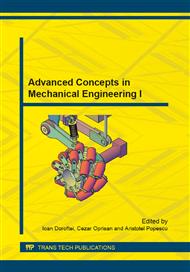p.690
p.694
p.700
p.706
p.712
p.718
p.724
p.730
p.736
Validation of the Expert System Used for Optimum Gripping Surfaces Identification for an Injection-Molded Part
Abstract:
This paper describes a validation method through experimental tests of the Expert System conceived for the identification of the optimum gripping surfaces for an injection-molded part, conceived by the authors. A number of experimental tests were conducted using a flexible vacuum end-effector. During experimental tests phases three different versions have been considered for experimenting in which different types of suction cup holders and different placements on the end-effector structure were analyzed. The part subjected to tests was a stove handle. The first version of the vacuum end-effector is composed of four rigid suction cup, their placement on the gripper being made on points randomly chosen. The second version of the end-effector is composed of four flexible suction cup holders equipped with spherical articulations; the axes adjustment on the gripped surfaces being made on four randomly chosen points. The third version is composed of four suction cup holders equipped with spherical articulations, the axes positions and points placement being offered by the Expert System.
Info:
Periodical:
Pages:
730-735
Citation:
Online since:
October 2014
Price:
Сopyright:
© 2014 Trans Tech Publications Ltd. All Rights Reserved
Share:
Citation:


